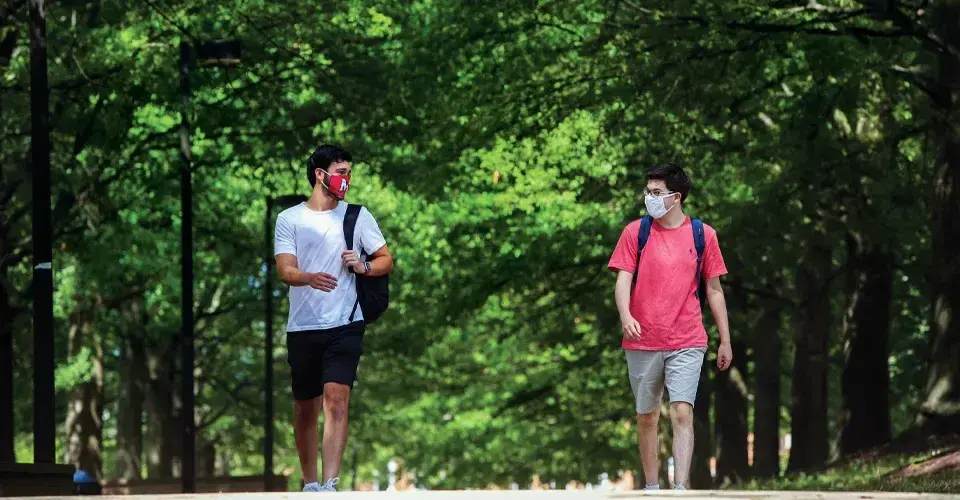UMD Takes Extraordinary Steps to Keep Virus at Bay
A De-densified Campus Gradually Reopens With Wide-Ranging Safety Measures ‘4 Maryland’
By Lauren Brown | Photo by Stephanie S. CordleMaryland Stadium hosting COVID-19 testing clinics rather than football practice. Stenciled shells on McKeldin Mall’s lawn marking areas where sun seekers can maintain physical distance. Open parking spaces at midday.
Terps coming to the University of Maryland this semester—a limited number, for sure—were expected to find a campus changed by sweeping measures meant to protect the community from the further spread of the coronavirus.
As of press time, the plan to gradually reopen following last spring’s shift to all-virtual learning calls for a mostly online experience this fall as well, along with “de-densified” residence halls and a swath of cleaning, health and safety precautions and protocols, collectively known as “4 Maryland.”
“To emerge as an even more engaged, vibrant and impactful university, it is essential that we adapt continuously to the trials and opportunities of our time,” President Darryll J. Pines said as he took the helm in July. “Our entire campus—students, faculty and staff—must prepare for this future, because what was ‘normal’ will no longer be the same.”
It all starts with four basic guidelines: wear a face covering, keep physically distanced from others, wash or sanitize your hands frequently, and stay home if you feel sick. Everyone on campus had to get tested before the semester started and is expected to check their temperature daily and report any symptoms, and the university is expanding testing opportunities and working with county and state health officials on contact tracing for anyone who tests positive.
Analyzing test results will allow the university to monitor health factors such as positivity rates and the need for isolation and quarantine spaces. Pines said, “We will not hesitate to pivot to more stringent measures if dictated by these initial assessments, and health conditions within our state, county or campus.”
Classrooms and “high-touch areas” such as elevator buttons, door handles and water fountains are all getting extra cleanings, and signs everywhere, from dining halls to lecture halls, indicate safe distances for seating or one-way traffic to reduce hallway congestion.
One factor easing some concern: There are far fewer Terps on campus. In-person undergraduate instruction was scheduled online for the first two weeks. Researchers and staffers are encouraged to work from home whenever possible. More than 80% of academic courses are fully online; hundreds were redesigned over the summer to boost students’ learning experience. Others blend the two formats. Faculty are preparing to go fully online, should an outbreak hit anytime this fall.
“We are committed to making the fall semester as rewarding, safe and inclusive as possible and striving for excellence no matter what the format of course delivery,” Senior Vice President and Provost Mary Ann Rankin said.
Planning an engaging, enjoyable student experience while prioritizing everyone’s health posed another set of challenges. Most undergraduates choosing to live in residence halls were assigned to single rooms, and lounges are closed to gatherings. In the dining halls, reservations are required, and self-service has been eliminated, while carryout stations popped up across campus.
The Big Ten postponed all fall sports, a blow to student-athletes and fans alike. The Eppley Recreation Center and Stamp Student Union opened with safety precautions, however, and Resident Life and Fraternity and Sorority Life planned to host outdoor programs and entertainment.
Perhaps more than ever, a successful fall depends on the care and safe behavior of students, staff and faculty, said Vice President for Student Affairs Patty Perillo, who exuded hope as the semester approached: “We promise to welcome our students with open arms, in lots of ways that are as safe as possible.”
0 Comments
Leave a Reply
* indicates a required field

